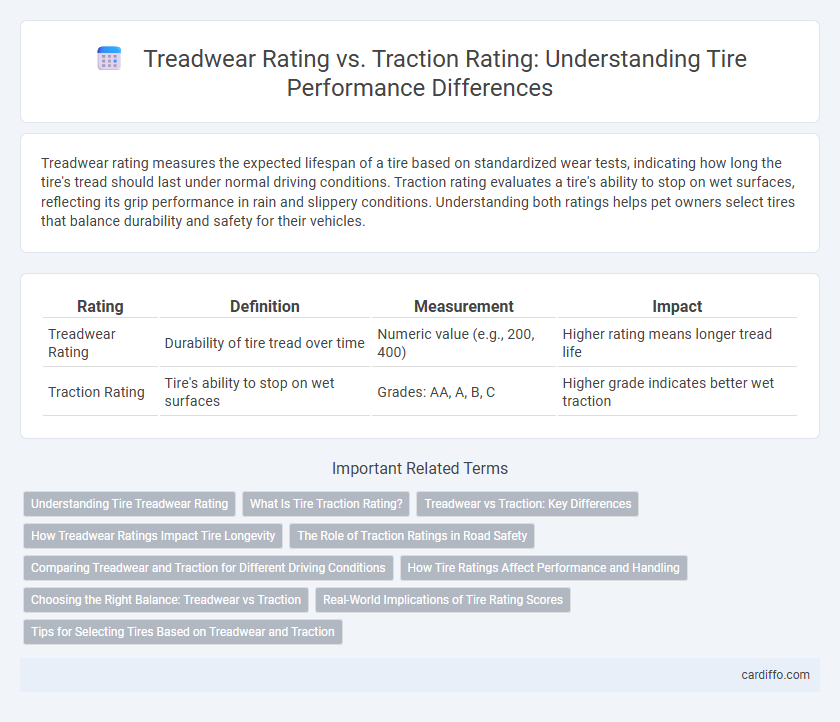Treadwear rating measures the expected lifespan of a tire based on standardized wear tests, indicating how long the tire's tread should last under normal driving conditions. Traction rating evaluates a tire's ability to stop on wet surfaces, reflecting its grip performance in rain and slippery conditions. Understanding both ratings helps pet owners select tires that balance durability and safety for their vehicles.
Table of Comparison
| Rating | Definition | Measurement | Impact |
|---|---|---|---|
| Treadwear Rating | Durability of tire tread over time | Numeric value (e.g., 200, 400) | Higher rating means longer tread life |
| Traction Rating | Tire's ability to stop on wet surfaces | Grades: AA, A, B, C | Higher grade indicates better wet traction |
Understanding Tire Treadwear Rating
Tire treadwear rating indicates the expected durability of the tire compound based on standardized testing, providing a numerical value that predicts how long the tread will last under controlled conditions. It helps consumers compare tire longevity, with higher numbers representing longer-lasting tires, while traction rating measures the tire's ability to stop on wet pavement, categorized as AA, A, B, or C. Understanding treadwear rating allows for informed decisions on tire lifespan, balancing performance and endurance according to driving needs.
What Is Tire Traction Rating?
Tire traction rating measures a tire's ability to stop on wet pavement, evaluated under controlled conditions and graded from AA (highest) to C (lowest) by the U.S. Department of Transportation. This rating directly impacts vehicle safety by indicating how well tires perform in wet or slippery conditions. Treadwear rating, on the other hand, estimates tire durability and wear rate, but traction rating specifically reflects the tire's grip performance on wet surfaces.
Treadwear vs Traction: Key Differences
Treadwear rating measures the expected durability of a tire's tread, expressed as a numerical value indicating how long the tire should last under standardized testing conditions. Traction rating evaluates the tire's ability to stop on wet pavement, categorized by grades such as AA, A, B, or C, with AA offering the highest traction performance. The key difference lies in treadwear rating emphasizing longevity and wear resistance, while traction rating focuses on safety and handling in wet conditions.
How Treadwear Ratings Impact Tire Longevity
Treadwear ratings provide a standardized measure of a tire's durability by indicating how long the tread is expected to last under normal driving conditions. Tires with higher treadwear ratings typically offer extended longevity but may compromise traction performance, which is reflected in the traction rating, assessing a tire's grip on wet surfaces. Understanding treadwear ratings helps consumers balance tire lifespan and safety requirements for optimal vehicle performance.
The Role of Traction Ratings in Road Safety
Traction ratings measure a tire's ability to stop on wet pavement, directly impacting vehicle safety during adverse weather conditions. Higher traction ratings, such as AA or A, indicate superior wet grip performance, reducing the risk of hydroplaning and improving braking distance. While treadwear ratings predict tire longevity, traction ratings are crucial for ensuring reliable control and stability on slippery roads.
Comparing Treadwear and Traction for Different Driving Conditions
Treadwear ratings measure a tire's durability by indicating how long the tread is expected to last under standardized conditions, with higher numbers representing longer life, while traction ratings assess a tire's ability to stop on wet pavement, graded from AA (highest) to C (lowest). For dry, everyday driving, tires with higher treadwear ratings provide better longevity, but in wet or slippery conditions, tires with superior traction ratings offer enhanced safety and stopping power. Choosing the right balance between treadwear and traction depends on driving habits and local weather; performance tires prioritize traction whereas touring tires emphasize tread life.
How Tire Ratings Affect Performance and Handling
Treadwear rating measures the expected durability of a tire's tread, indicating how long the tire will maintain grip and performance before wearing out, which directly impacts long-term handling consistency. Traction rating assesses a tire's ability to stop on wet pavement, influencing short-term braking performance and road safety during adverse conditions. Understanding the balance between treadwear and traction ratings helps optimize tire selection for specific driving needs, ensuring enhanced vehicle control and reliable performance.
Choosing the Right Balance: Treadwear vs Traction
Selecting tires requires balancing treadwear rating, which measures durability, against traction rating that indicates grip performance in wet and dry conditions. Higher treadwear ratings typically mean longer tire lifespan but may compromise traction, affecting safety and handling. Prioritize traction ratings when driving on wet or slippery roads, while opting for higher treadwear ratings benefits those seeking extended tire life.
Real-World Implications of Tire Rating Scores
Treadwear ratings provide an estimate of a tire's durability by indicating how long the tire's tread is expected to last under standardized testing conditions, directly affecting replacement frequency and overall cost of ownership. Traction ratings measure a tire's ability to stop on wet surfaces, which translates to real-world safety performance in rainy or slippery conditions. Understanding both ratings helps consumers balance longevity with safety, ensuring the tire meets their driving environment and performance needs effectively.
Tips for Selecting Tires Based on Treadwear and Traction
When selecting tires, prioritize treadwear ratings to gauge tire longevity, with higher numbers indicating longer lifespan and better value over time. Traction ratings, marked as AA, A, B, or C, measure a tire's ability to stop on wet surfaces, with AA representing superior performance and safety in wet conditions. Balancing a tire with a high treadwear rating and a top-tier traction rating ensures optimal durability and reliable grip, crucial for safe driving in diverse weather conditions.
Treadwear rating vs Traction rating Infographic

 cardiffo.com
cardiffo.com